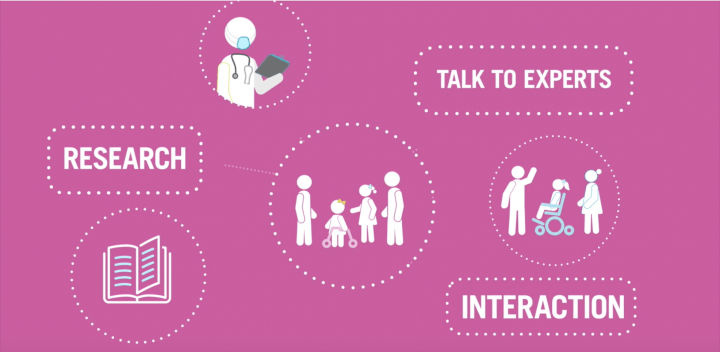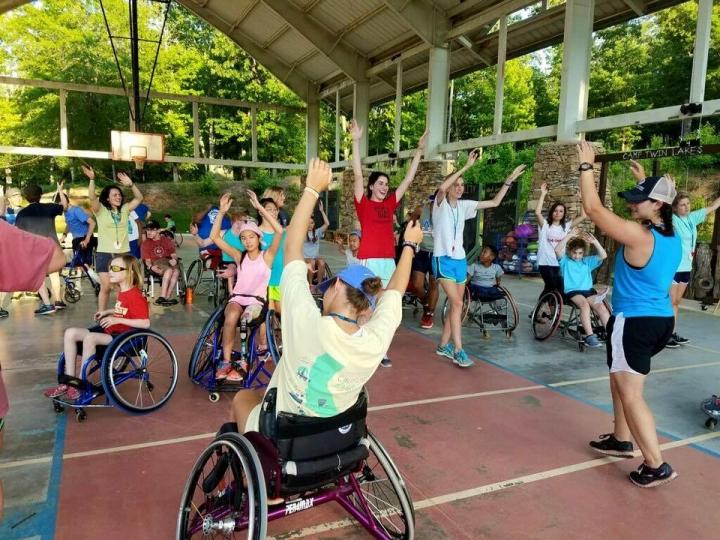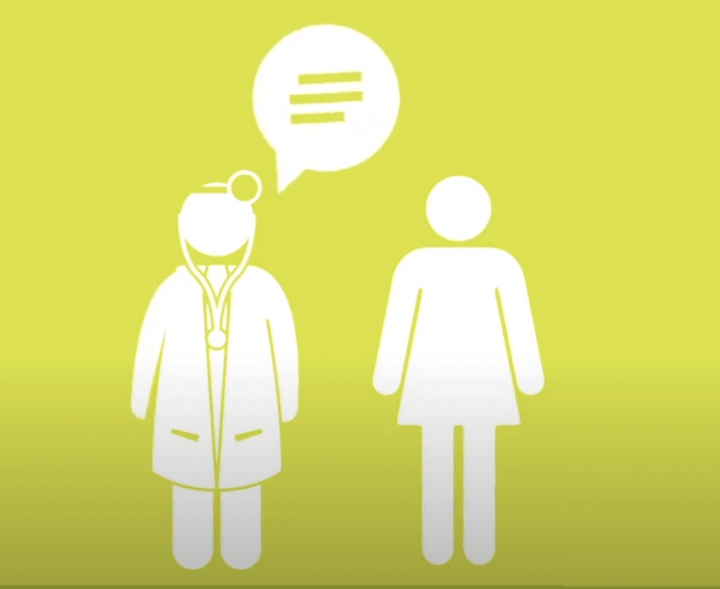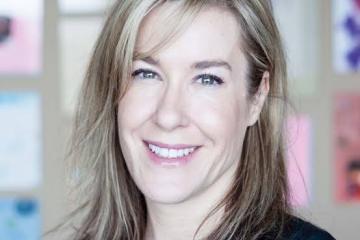Primary Care for Children and Youth with CP

The American Academy of Pediatrics (AAP) and the American Academy for Cerebral Palsy and Developmental Medicine (AACPDM) have recently provided updated guidance for physicians within the clinical report, “Providing a Primary Care Medical Home for Children and Youth with Cerebral Palsy.”
Last published in 2006, this guidance is for the primary care for children and youth with cerebral palsy and reflects the fact that primary care pediatricians are often in a position to identify babies with cerebral palsy, and, once diagnosed, they must be familiar with the what cerebral palsy means, what it can look like, and how it is treated or managed. Primary Care Pediatricians will need to collaborate and coordinate care with specialists, including developmental, orthopedic, therapies, behavioral, neurologic and more; while also providing primary care.
The Cerebral Palsy Foundation has created this checklist to help summarize this guidance so that families can follow along, share with your provider, and know what other issues to address or may be addressed at your appointments. We urge you to ask your pediatrician if they have read the clinical report.
What is primary healthcare?
Primary healthcare includes health care services like physical exams, screenings, tests, vaccines, and even talking with your child's doctor about healthy habits. General pediatricians keep tabs on preventive care that can help your child stay healthy, avoid or delay getting sick, and catch problems early when treatment is likely to work best.
Which basic preventive care services do CHIlDREN ANd ADOLESCENTS need?
There are healthcare services that all children need whether or not they have cerebral palsy. The clinical report recommends that pediatricians follow the "Bright Futures" guidelines for standard primary care visits to promote health, wellbeing, optimal growth and development. Bright Futures Guidelines
This chart reflects general recommendations and is not a full listing of all guidelines. Periodicity Schedule
- Infancy: Birth - 9 Mo
- Early Childhood: 12 Mo - 4 Year
- Middle Childhood: 5 Year - 10 Year
- Adolescence: 11 Year - 21 Year
- Newborn Screenings - Bilirubin, Blood, Congenital Heart Defect
- Physical Exam
- Measurements (height, weight for length, head circumference)
- Blood Pressure
- Developmental Surveillance (newborn, 1mo, 2 mo, 4mo, 6 mo)*
- Developmental Screening (9 mo)*
- Sensory Screenings - Vision and Hearing ***
- Behavioral Surveillance
- Oral Health
- Immunizations
- Physical Exam
- Measurements (height, weight, head circumference, body mass index)
- Blood Pressure
- Developmental Surveillance (18 and 30 mo)*
- Sensory Screenings - Vision and Hearing **
- Autism Spectrum Disorder
- Behavioral Surveillance
- Oral Health
- Immunizations
- Physical Exam
- Measurements (height, weight, body mass index)
- Blood Pressure
- Sensory Screenings - Vision and Hearing **
- Behavioral Surveillance
- Oral Health
- Immunizations
- Physical Exam
- Measurements (height, weight, body mass index)
- Blood Pressure
- Sensory Screenings - Vision and Hearing **
- Behavioral Surveillance, social, emotional
- Immunizations
* AAP / AACPDM Notes that Pediatricians should adopt surveillance and screening as they are important for early detection, diagnosis and intervention of CP to ensure babies get early intervention of evidence based therapies to maximize neuroplasticity.
**AAP / AACPDM Notes that Sensory Screenings and Vaccinations are particularly important for children with disabilities such as CP.
- Early Detection and Intervention
- Care Coordination, Resources and Education
- Adaptive Recreation, Leisure and Fitness
- Adolescence and Puberty
- Pain
- Transition
- Complementary, Alternative and Unproven Treatments
EARLY DETECTION AND IDENTIFICATION:
- Pediatricians should recognize infants who have a greater likelyhood of CP (premies, hospitalized newborns, or other pre- or perinatal problems) and should work with neonatal follow-up programs to evaluate these babies using validated tools for early diagnosis - See AACPDM Early Detection Care Pathway: https://www.aacpdm.org/publications/care-pathways/early-detection-of-cerebral-palsy
- PCP's should utilize formal developmental surveillance as recommended by AAP at 9,18, and 30 months and should include screening for motor disorders with attention towards milestones and muscle tone.
- When a child has been identified as having or being at risk for CP, the clinical report recommends the PCP take 3 actions simultaneously:
- Initiate diagnostic workup.
2. Refer to a medical specialist to complete the diagnostic evaluation
3. Refer to Early Intervention for treatment
EARLY INTERVENTION:
- Evidence-based motor therapies can improve outcomes by taking advantage of neuroplasticity in the developing infant brain.
- Therapies should be multi-disciplinary and family centered.
- Interventions aim to:
- Optimize Function and Independence
- Promote Participation in Activities
- Minimize Secondary Musculoskeletal Deformity
- Enhance Quality of Life
Care Coordination and Resources: PCP's should integrate care across multiple disciplines, and refer children to local and State resources, including but not limited to:
- Medical Specialists
- Therapists or other health providers (such as Physical Therapists, Occupational Therapists, Speech Therapists, Dentists)
- Early Intervention or School Services
- SSI, Medicaid and Home and Community Based Services Waivers
- Community Health Workers
- Family Support Groups or other community resources
- Home Health Care and Equipment Vendors
- Adaptive Recreation Programs
Providers should engage in Patient and Family Centered Care: the planning, delivery, and evaluation of health care is grounded in mutually beneficial partnerships among health care providers, patients, and families.
Providers are encouraged to utilize the ICF approach to healthcare with children with CP, http://learn.phsa.ca/shhc/icf/story_html5.html, which integrates social, environmental, personal, family factors with health conditions. This model encourages:
1. Shared Decision Making - PCP's should facilitate family choice and control.
2. Coordinated Care - Care should be integrated across multiple specialists and community services.
3. Treatments and Interventions that promote the goals and strengths of the family - Clinicians should work with the family in setting goals that build upon the strengths of the child and the family
Education: Pediatricians should discuss and review the child's academic evaluations and placements to ensure educational services are provided in the Least Restrictive Environment for the child and that the child has the proper supports in place to successfully learn and grow.
Disparities: Of note, AAP recognizes that CP is more prevalent in Black children and those who come from lower socioeconomic backgrounds. It encourages pediatricians to recognize disparities and identify and eliminate barriers to screening, identification, treatment and family support so that care may be improved for those most vulnerable.
Risk of Abuse, Neglect or Maltreatment: Pediatricians can help educate and support and provide resources to caregivers about prevention and indicators of abuse.

Pediatricians are encouraged to help children with CP participate and engage in Adaptive Recreation and Leisure activities, Adaptive PE and Sports.
Exercise and physical fitness are vitally important for people with cerebral palsy to improve quality of life and help prevent declines in mobility, build strength, cardiovascular health and mental health. Pediatricians should play a leading role in helping children and families find the resources to develop healthy exercise, fitness habits early on. Additionally recreation, leisure and sports activities promote friendships, independence, and build skills.
Pediatricians should:
1) Talk to the child and family about what they like to do for fun
2) Explore with the family local opportunities for participation
3) Provide guidance for what activities are appropriate for your child.
Primary care pediatricians should be prepared to discuss with youth and families issues surrounding adolescence, puberty and sexual health and should not be ignored for those with CP. It is recommended that these discussions begin with the family and youth early and should be modified to accommodate intellectual needs. Pediatricians should be sure to discuss:
- Early or late onset puberty
- Menstrual Management
- Mental Health
- Sexual Activity
- Prevention of Sexual Abuse and Internet Safety
- Prevention of Sexually Transmitted Infections (STIs)
Pediatricians should screen for pain at every visit. Children and adolescents with CP have a high frequency of pain, experience it for a variety of reasons, and it can be acute, chronic, recurrent or constant. Pediatricians should work with the patient and family to identify, treat and monitor the source of pain and this often may require a multidisciplinary approach.
Of note, pain can be manifested by changes in behavior, so it is particularly important for pediatricians to communicate with parents at each visit to gain an understanding of the child's baseline without pain, especially for those children who are unable to communicate or have intellectual developmental disorder.
Pediatricians play a critical role in health care transition from pediatrics to adult medical providers for children and youth with cerebral palsy.
The AAP/AACPDM clinical report provides guidance that this transition process should begin as early as ages 12-14. Their practice should have a practice transition policy and individual transition plans should be developed and implemented by the pediatrician together with the youth and family.
Pediatricians can also play a role in preparation for adulthood for adolescents with CP and their families by assisting with legal aspects of transition that may include guardianship or supported decision making agreements, and wills or special needs trusts. Additionally pediatricians can play a role on the multidisciplinary team to plan for and provide resources for housing, employment, education, transportation and more.
Resources Include:
Got Transition: https://www.gottransition.org/resource/?hct-family-toolkit
Child Neurology Foundation Transition of Care Toolkit: https://www.childneurologyfoundation.org/wp-content/uploads/2020/10/CNF-2020-Transition-of-Care-Toolkit.pdf
Health Care For Adults with Intellectual and Developmental Disabilities Toolkit: https://iddtoolkit.vkcsites.org/
Many caregivers of children with disabilities such as CP seek out and utilize complementary and alternative medicine approaches to help their children.
The clinical report refers to these definitions from the National Center for Complementary and Integrative Health:
Complementary Therapies are evidence based health care approaches developed outside conventional Western medicine that are used in conjunction with conventional care.
Alternative Therapies are not evidence based and are used in place of conventional care.
The AAP provides comprehensive guidance to pediatricians to regularly ask families about CAM use and to seek out evidence-based information about the safety and effectiveness of specific therapies in order to discuss risks and benefits.
Infants, children and adolescents with cerebral palsy have additional health considerations to keep in mind. Primary care pediatricians should be prepared to identify, discuss and manage a variety of health concerns, these include:
Cognition and Learning
Specific Learning difficulties and intellectual disability are common in CP, though not all individuals with CP have these challenges and it is recommended that pediatricians both:
- Do not assume someone with CP has intellectual differences based on motor impairment
- Refer individuals for testing with specialists if there are concerns for learning or intellectual challenges.
Communication, Speech and Language
Many children and adolescents with CP have difficulties with communication and it is important to identify and treat speech issues early. Pediatricians should refer children for speech and language evaluation as soon as a delay is detected. The guidelines also provide helpful information for pediatricians on the use of alternative and augmentative communication devices (AAC).
Behavior and Mental Health
The Primary Care Pediatrician plays an important role in identifying symptoms of behavioral or mental health conditions as well as recognizing medical conditions that may causing a child or adolescent with CP physical discomfort that may be impacting behavior. In addition they serve to coordinate care with specialists, and provide support to patients and parents.
Epilepsy
Epilepsy commonly occurs with CP and your pediatrician should ask if your child has had symptoms such as apnea, staring, posturing, sleepiness, or developmental regression. Your pediatrician will likely work together with a neurologist to manage epilepsy treatment.
Sensory Impairments
Individuals with CP have increased frequency of Hearing (4%-13% of individuals with CP) and Visual (50-90% of individuals with CP) Impairment. Pediatricians should screen for and address these issues as early as possible to maximize neuroplasticity and provide accommodations to maximize learning and participation.
Pulmonary Issues
Pulmonary Complications are the leading cause of hospitalizations and death for children and adolescents with CP. Providers can help prevent pulmonary complications in children with CP by:
- Providing immunizations for common respiratory diseases.
- Screening for signs and symptoms of sleep-disordered breathing.
- Screening for signs and symptoms of aspiration.
Sleep
Many children with CP have difficulties falling and staying asleep. They are important to address because they can impact daytime function of the child, and often disrupt parent sleep and wellbeing.
Pediatricians should address sleep by providing guidance on sleep hygiene and behavior strategies, and managing conditions that are causing sleep disruptions such as GERD (reflux), Constipation, Pain, or Sleep Apnea.
Nutrition, Growth and Gastrointestinal Issues
Feeding difficulties, inadequate nutrition, poor growth, and gastrointestinal issues are all common for children and adolescents with CP. Pediatricians should assess and monitor:
- Growth and Nutrition
- Feeding Methods and Diet
- Gastrointestinal Issues
- Drooling - The guidelines suggest pediatricians utilize the AACPDM care pathway to address drooling: https://www.aacpdm.org/publications/care-pathways/sialorrhea-in-cerebral-palsy
Urinary Problems
Urinary incontinence is common and can be caused by physical, cognitive, communication, and even environmental factors (such as lack of access to adaptive toilets or caregiver assistance). Pediatricians should discuss incontinence with families and provide guidance surrounding behavioral or medical interventions and should provide prescriptions for adaptive toileting equipment to assist with toilet training and independence.
Bone Health
Pediatricians should monitor bone health in children and adolescents with cerebral palsy, especially those who are non ambulatory or do not weight bear, take certain medications, have a history of prematurity or poor nutrition.
The guidelines recommend that pediatricians refer to the AACPDM care pathways for osteoporosis to monitor and treat bone health: Osteoporosis Care Pathway
Strengthening and Tone Management
Children with cerebral palsy may have differences in muscle tone, such as spasticity or dystonia, and they may have muscle weakness. It is important for pediatricians to identify and refer children who may benefit from medical management of tone by a specialist; and it is important for pediatricians to encourage children to build strength through resistance training exercise programs with the assistance of physical and recreational therapists and adaptive physical educators or personal trainers.
Orthopedic Issues
Many children and adolescents experience issues of the hips, joints and spine which can impact function and/or personal care and can cause pain, pressure injuries, deformities. Pediatricians play a key role in early detection and management of orthopedic issues in cerebral palsy by:
- Ordering screening x-rays
- Referring to orthopedics if necessary
- Ensuring follow-up with orthopedics
- Optimizing health pre-and-post surgery
The AACPDM has created a hip surveillance care pathway for pediatricians to utilize: Hip Surveillance Care Pathway

It is important to find a Pediatrician who understands your child's unique needs. While not every provider will have significant experience caring for children with cerebral palsy, there are many who do and all pediatricians are expected to be familiar with the "definition, manifestations and management of cerebral palsy". Importantly, you will want to be comfortable that your doctor will listen to you and your specific needs, as well as have the qualifications and knowledge you want. Depending on your healthcare insurance plan, there may be a variety of resources to help you select a primary care physician in your area.
If your child has a mobility challenges, it’s important to remember that the accessibility of the office and the exam room will be important to you and you want to ask about that before making an appointment.
1. Do you have experience treating children with cerebral palsy?
2. Have your read the updated AAP/AACPDM Cerebral Palsy clinical report?
3. Are you, your partners and your office staff comfortable treating children with cerebral palsy and related disabilities? And who will see my child if you are not available?
4. Are you able to see my child for longer appointments if needed, to ensure that all my healthcare needs are addressed?
5. Can your office accommodate my child's physical needs? (i.e. is there accessible parking, additional space in the exam room for my caregiver if needed, movable exam table, etc.)
6. Are you able to coordinate my child's care across providers?
7. Are you familiar with State Disability/Home and Community Based Services?
8. Are you familiar with local educational, recreation/leisure, adaptive sports resources?
9. Planning for transition to adulthood, does your practice have a transition policy? Do you have a network of providers who you work closely with to ensure a smooth transition?
10. Does your office have capability to do bloodwork and other procedures "in house" or will I to take my child to multiple locations?
Noritz G, Davidson L, Steingass K, et al; Council on Children With Disabilities, the American Academy For Cerebral Palsy and Developmental Medicine. Providing a Primary Care Medical Home for Children and Youth With Cerebral Palsy. Pediatrics. 2022;150(6):e2022060055
Noritz G, Davidson L, Steingass K, et al; Council on Children With Disabilities, and the American Academy For Cerebral Palsy and Developmental Medicine. Executive Summary: Providing a Primary Care Medical Home for Children and Youth With Cerebral Palsy. Pediatrics. 2022; 150(6):e2022060056
McClafferty H, Vohra S, Bailey M, et al; Section on Integrative Medicine. Pediatric integrative medicine. Pediatrics. 2017;140(3):e20171961





